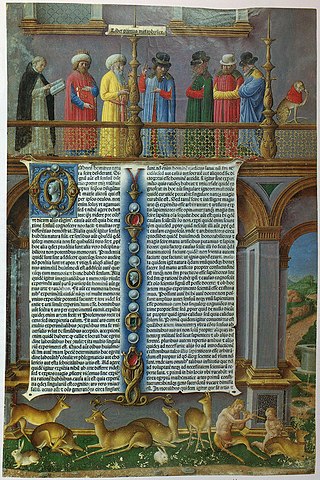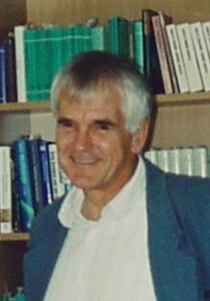
Metaphysics is the branch of philosophy that examines the fundamental structure of reality. Aristotle conceived the scope of metaphysics under the title first philosophy. It is traditionally seen as the study of mind-independent features of reality, but some modern theorists understand it as rather an inquiry into the conceptual schemes that underlie human thought and experience.

In the philosophy of space and time, eternalism is an approach to the ontological nature of time, which takes the view that all existence in time is equally real, as opposed to presentism or the growing block universe theory of time, in which at least the future is not the same as any other time. Some forms of eternalism give time a similar ontology to that of space, as a dimension, with different times being as real as different places, and future events are "already there" in the same sense other places are already there, and that there is no objective flow of time.
Mereology is the philosophical study of part-whole relationships, also called parthood relationships. As a branch of metaphysics, mereology examines the connections between parts and their wholes, exploring how components interact within a system. This theory has roots in ancient philosophy, with significant contributions from Plato, Aristotle, and later, medieval and Renaissance thinkers like Thomas Aquinas and John Duns Scotus. Mereology gained formal recognition in the 20th century through the pioneering works of Polish logician Stanisław Leśniewski, who introduced it as part of a comprehensive framework for logic and mathematics, and coined the word "mereology". The field has since evolved to encompass a variety of applications in ontology, natural language semantics, and the cognitive sciences, influencing our understanding of structures ranging from linguistic constructs to biological systems.
Roderick Milton Chisholm was an American philosopher known for his work on epistemology, metaphysics, free will, value theory, and the philosophy of perception.
Modal realism is the view propounded by philosopher David Lewis that all possible worlds are real in the same way as is the actual world: they are "of a kind with this world of ours." It is based on four tenets: possible worlds exist, possible worlds are not different in kind from the actual world, possible worlds are irreducible entities, and the term actual in actual world is indexical, i.e. any subject can declare their world to be the actual one, much as they label the place they are "here" and the time they are "now".
Peter van Inwagen is an American analytic philosopher and the John Cardinal O'Hara Professor of Philosophy at the University of Notre Dame. He is also a research professor of philosophy at Duke University each spring. He previously taught at Syracuse University, earning his PhD from the University of Rochester in 1969 under the direction of Richard Taylor. Van Inwagen is one of the leading figures in contemporary metaphysics, philosophy of religion, and philosophy of action. He was the president of the Society of Christian Philosophers from 2010 to 2013.
Perdurantism or perdurance theory is a philosophical theory of persistence and identity. The debate over persistence currently involves three competing theories—one three-dimensionalist theory called "endurantism" and two four-dimensionalist theories called "perdurantism" and "exdurantism". For a perdurantist, all objects are considered to be four-dimensional worms and they make up the different regions of spacetime. It is a fusion of all the perdurant's instantaneous time slices compiled and blended into a complete mereological whole. Perdurantism posits that temporal parts alone are what ultimately change. Katherine Hawley in How Things Persist states that change is "the possession of different properties by different temporal parts of an object".

An infinite regress is an infinite series of entities governed by a recursive principle that determines how each entity in the series depends on or is produced by its predecessor.
In philosophy, mereological nihilism is the metaphysical thesis that there are no objects with proper parts. Equivalently, mereological nihilism says that mereological simples, or objects without any proper parts, are the only material objects that exist. Mereological nihilism is distinct from ordinary nihilism insofar as ordinary nihilism typically focuses on the nonexistence of common metaphysical assumptions such as ethical truths and objective meaning, rather than the nonexistence of composite objects.
In mathematics, point-free geometry is a geometry whose primitive ontological notion is region rather than point. Two axiomatic systems are set out below, one grounded in mereology, the other in mereotopology and known as connection theory.
In philosophy, four-dimensionalism is the ontological position that an object's persistence through time is like its extension through space. Thus, an object that exists in time has temporal parts in the various subregions of the total region of time it occupies, just like an object that exists in a region of space has at least one part in every subregion of that space.
In contemporary metaphysics, temporal parts are the parts of an object that exist in time. A temporal part would be something like "the first year of a person's life", or "all of a table from between 10:00 a.m. on June 21, 1994 to 11:00 p.m. on July 23, 1996". The term is used in the debate over the persistence of material objects. Objects typically have parts that exist in space—a human body, for example, has spatial parts like hands, feet, and legs. Some metaphysicists believe objects have temporal parts as well.
In philosophy, mereological essentialism is a mereological thesis about the relationship between wholes, their parts, and the conditions of their persistence. According to mereological essentialism, objects have their parts necessarily. If an object were to lose or gain a part, it would cease to exist; it would no longer be the original object but a new and different one.
The B-theory of time, also called the "tenseless theory of time", is one of two positions regarding the temporal ordering of events in the philosophy of time. B-theorists argue that the flow of time is only a subjective illusion of human consciousness, that the past, present, and future are equally real, and that time is tenseless: temporal becoming is not an objective feature of reality. Therefore, there is nothing privileged about the present, ontologically speaking.
Jonathan Schaffer is an American philosopher specializing in metaphysics and also working in epistemology, mind, and language. He is best known for his work on grounding and his development of monism, and is also a notable proponent of contrastivism.
In philosophy, specifically in the area of metaphysics, counterpart theory is an alternative to standard (Kripkean) possible-worlds semantics for interpreting quantified modal logic. Counterpart theory still presupposes possible worlds, but differs in certain important respects from the Kripkean view. The form of the theory most commonly cited was developed by David Lewis, first in a paper and later in his book On the Plurality of Worlds.
In mereology, an area of metaphysics, the term gunk applies to any whole whose parts all have further proper parts. That is, a gunky object is not made of indivisible atoms or simples. Because parthood is transitive, any part of gunk is itself gunk. The term was first used by David Lewis in his work Parts of Classes (1991), in which he conceived of the possibility of "atomless gunk", which was shortened to "gunk" by later writers. Dean W. Zimmerman defends the possibility of atomless gunk.

Arno Ros is a German philosopher and Professor of Theoretical Philosophy at the Otto-von-Guericke University Magdeburg in Magdeburg, Germany.
Compositional objects are wholes instantiated by collections of parts. If an ontology wishes to permit the inclusion of compositional objects it must define which collections of objects are to be considered parts composing a whole. Mereology, the study of relationships between parts and their wholes, provides specifications on how parts must relate to one another in order to compose a whole.
This is a glossary of mereology. Mereology is the philosophical study of part-whole relationships, also called parthood relationships.



